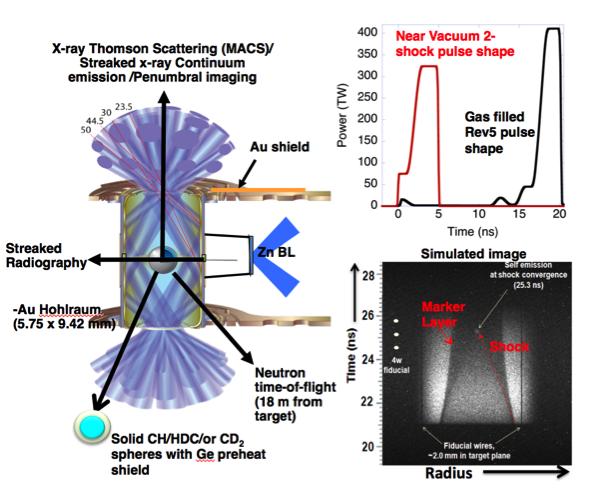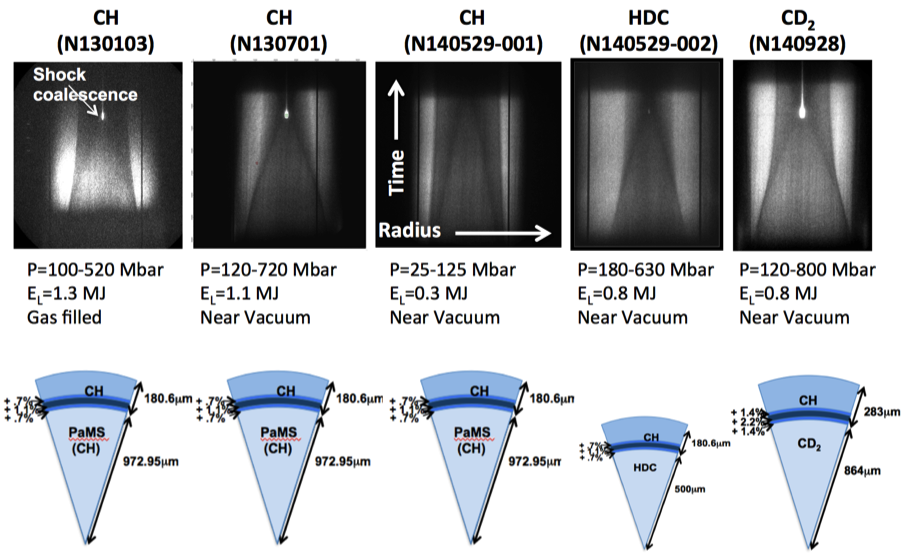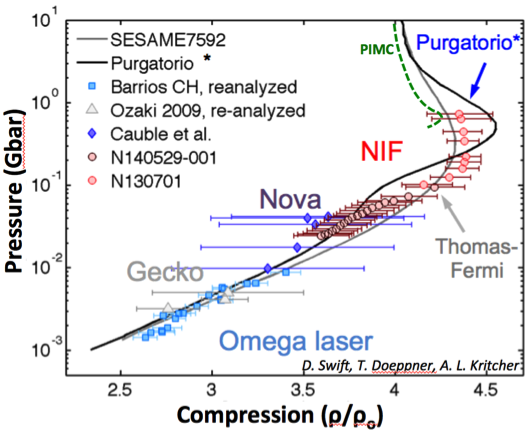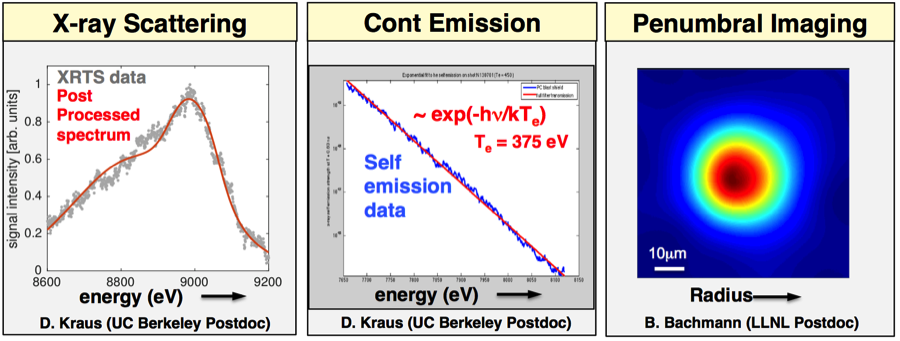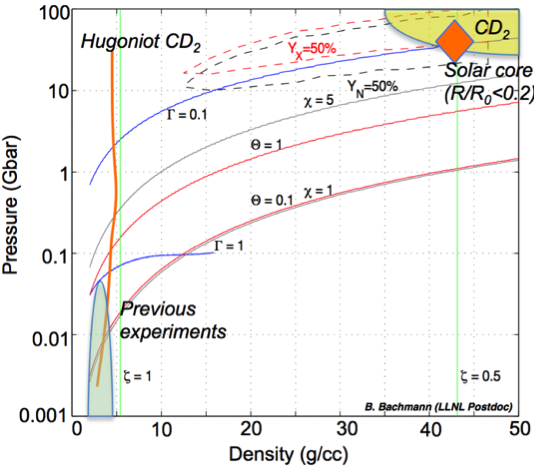Andrea Kritcher (13-ERD-073)
Abstract
We have measured the equation of state of matter at the highest pressures ever achieved in the laboratory. With this research effort, we have developed a new platform and completed six successful experiments, obtaining high-quality data. To create bulk matter at high pressures, we launched spherically convergent shock waves into solid spheres using an indirectly driven hohlraum (target capsule) radiation drive at Lawrence Livermore's National Ignition Facility. Through direct measurement of density, pressure, and shock speed, we constrained the equation of state without relying on accurate drive characterization. In this work, we have measured the Hugoniot (a curve of compression states for analyzing a material's equation of state) for various forms of carbon at pressures from 25 to 800 Mbar. We have completed new state-of-the-art calculations of the carbyne (CH) Hugoniot to compare to experimental data using several methods. The density-weighted electron temperature and carbon ionization state after shock coalescence at the center of the sample were characterized using x-ray Thomson scattering and x-ray spectroscopy of the bremsstrahlung self-emission (electromagnetic radiation produced by the acceleration of an electrically charged particle). Furthermore, we have probed the equation of state of material at densities greater than 40 g/cm3 and temperatures near 1 keV that occurs in the shock flash at the center of a sample using nuclear reactions, x-ray self-emission spectroscopy, and penumbral imaging of the shock flash (use of the shadow created by a light source after impinging on an opaque object). We additionally tested the models used to calculate the hohlraum radiation drive by probing the ion temperature in the interior of the hohlraum. As a result of the success of this project, this platform has been incorporated into a Livermore programmatic effort to measure the equation of state of various materials. In addition, basic science proposals motivated by this work to study the physics of matter at extreme conditions have recently been submitted to the National Ignition Facility Discovery Science Program, by outside international leaders in the field.
Background and Research Objectives
Matter at extreme pressures, of 50 Mbar to greater than 1 Gbar (about a billion Earth atmospheres), occurs in astrophysical objects such as gas-giant planets. The equation of state at these pressures—that is, the behavior of matter under a given set of physical conditions—has not been measured for any material. Laboratory measurements of the equation of state of matter at high energy density is of great importance in understanding the structure and evolution of these objects and for accurate modeling of matter at extreme conditions. For example, at gigabar pressures, atomic shell effects may come into play,1 which can change the predicted compressibility at given pressure because of pressure and temperature ionization. In addition, benchmarking models in this regime are of interest for fusion experiments.2 Recent advances in experimental capabilities to create high-energy-density plasmas using high-energy lasers at the National Ignition Facility provides access to these astrophysics-relevant conditions in the laboratory.
The main objective of this work was to measure the equation of state of material at near gigabar pressures and characterize the density-weighted electron temperature. Prior to this work, planar shock-wave-driven experiments using high-powered lasers have measured the equation of state of material to higher pressures than can be achieved using historical techniques of diamond anvil cells and gas guns. However, planar shock-wave equation-of-state experiments are restricted to pressures of less than 100 Mbar for the millimeter-size samples required for accurate characterization.3
During the course of this research, we have met our objectives by developing a spherically convergent shock-wave platform to create and probe the equation of state of material at high pressures, ranging from 25 to greater than 800 Mbar in bulk millimeter-scale plasmas.4–13 We have measured the Hugoniot in the pressure range of 25 to 720 Mbar for CH;7–9 180 to 630 Mbar for high-density carbon (HDC, or diamond);10 and 120 to 800 Mbar for deuterated polyethylene (CD2).11 In addition to our original goals, we have probed conditions relevant to the center of the sun (>40 Gbar) by measuring neutron and x-ray emission from coalescence of the spherically convergent shock wave at the center of a CD2 sphere. We have also benchmarked models used to calculate hohlraum radiation drive in Inertial Confinement Fusion experiments and have probed the ion heating in hohlraum plasmas with a novel diagnostic. Finally, we have verified the electron temperature measurement using x-ray Thomson scattering with a second method of spectroscopy of the bremsstrahlung x-ray self-emission.
Scientific Approach and Accomplishments
We have created matter at near-gigabar pressures by launching spherically convergent shock waves into solid balls of poly(alpha-methylstyrene) (PAMS, C9H10), HDC, carbon–deuterium (CD), and CD2 using a hohlraum radiation drive. We used a standard Livermore National Ignition Campaign–scale 5.75 gold cylindrical hohlraum with two different gas fill densities of 0.96 mg/cm3 (gas filled) and 0.03 mg/cm3 (near vacuum) helium-4. The hohlraum was driven by up to 184 laser beams with either a Rev5 ignition pulse shape for shots with a gas-filled hohlraum, or a two-shock pulse shape for shots with a near-vacuum hohlraum. See Figure 1 (right, top) for the laser profiles versus time. The laser peak power and total drive energy were varied to access different pressure regimes along the Hugoniot, to overlap with previous data and reach record pressures in the laboratory.
We characterized the shocked material using streaked x-ray radiography along the equator with a 9.0-keV zinc and helium-alpha x-ray backlighter. The experiments were designed and analyzed with radiation hydrodynamic simulations using the HYDRA code, which is used to help design targets for the National Ignition Facility.5 A schematic of the experimental configuration and a simulated radiograph are shown in Figure 1.
Measured x-ray radiographs for the shots we completed are shown in Figure 2. A schematic of the target configuration for each shot is shown on the bottom. The targets were solid spherical samples, over-coated with a graded germanium-doped layer to mitigate preheat and serve as a spatial fiducial for the radiographic unfold. The pressure range for each shot (P), laser energy (EL), hohlraum gas fill, and pulse shape are also listed. We directly determined the shock speed from the temporally and spatially resolved radiographs. The mass density profiles were determined from the radiograph using profile matching to unfold the radial profiles. At pressures approximately greater than 85 Mbar, the opacity deviates from cold opacity and was simultaneously unfolded from the radiograph. With measurement of the mass density and the shock speed as a function of time, the pressure is determined using Hugoniot jump relations. The Hugoniot is thus constrained without detailed knowledge of the radiation drive. However, good agreement between the simulated and experimental shock-front radii versus time and transmission profiles were found (see the simulated radiograph in Figure 1 versus the data for shot N130103 in Figure 2).
Experimental Hugoniot points extracted from the radiographs for CH (shots N130701 and N140529-001) are shown in Figure 3. The data (red and pink points) are plotted together with previous data at lower pressures and several theoretical curves.14 We find that the data overlap with previous measurements from planar experiments3 and agree with the Purgatorio equation of state at low pressures. However, at higher pressures, the data more closely follow the Thomas–Fermi equation of state. The theoretical increase in compression at near-gigabar pressures predicted by Purgatorio, as compared to Thomas–Fermi theory, is a result of carbon ionization or shell effects. Path-integral Monte Carlo simulations also show a reduction in shell effects at high pressures,14 consistent with the data. In this method, no mean-field approximations were made regarding the many-electron problem, and the treatment is beyond the average-atom method, allowing for the detailed description of a distribution of the ionization stage.
Figure 3. Hugoniot data (red points) plotted together with previous measurements and theoretical curves for carbyne (CH) laser shots.
We probed the density-weighted electron temperature using x-ray Thomson scattering after shock coalescence15–18 and found good agreement with temperature inferred from time-resolved spectroscopy of the bremsstrahlung emission19 (Figure 4). The scattered x-ray spectrum is Doppler broadened (broadening of spectral lines from the Doppler effect caused by a distribution of velocities of atoms or molecules), and the width of the Compton feature down-scattered (alteration of the photon spectrum from interactions with electrons) in energy from 9.0 keV reflects the electron velocity distribution, and thus the electron temperature in a non-degenerate plasma. We show a strong sensitivity of the data to the degree of K-shell ionization, which was higher than predicted. In these experiments, the scattering was weighted to the bulk expanding material and is currently being further optimized to probe the temperature closer to the shock front in future experiments.
We also used this platform to probe the equation of state of material at pressures exceeding previous measurements by three orders of magnitude. The pressure in the shock flash region, when the shock coalesces at the center of the target, reaches about 40 Gbar at densities and temperatures found in the core of our Sun (Figure 5). An electron temperature of approximately 1.6 keV was inferred from temporally resolved spectroscopy of the bremsstrahlung emission and the spatial extent of the flash was measured using penumbral imaging (Figure 4, right).20 These extreme temperatures result in the creation of 2.45-MeV D(d,n) helium-3 neutrons (deuterium–deuterium reaction) from nuclear fusion reactions in the core plasma. The ion temperature is determined from the neutron spectrum that is Doppler broadening from deuterium's thermal temperature. Then, the number density is calculated from the absolute neutron yield, shock-flash volume, burn duration, and temperature. With a measure of the density and temperature, and assuming an equation of state, an average pressure of about 40 Gbar was inferred.
Figure 5. Phase diagram of CD2 showing the temperature and density range of the shock-flash region measured in this work (orange diamond).
In addition to the five shots described above, we tested the radiation hydrodynamic models used to predict the hohlraum x-ray drive and measured the ion heating of the hohlraum plasma in a separate shot with a bare CD sphere.21 In this experiment we measured deuterium–deuterium neutrons from the interaction of ablated CD with the hohlraum wall. A reduction in the yield compared to simulation by a factor of about three indicates mixing of the ablated CD with the low-pressure gas fill and gold hohlraum wall, which is also an issue in Inertial Confinement Fusion experiments.
Impact on Mission
Our high-energy-density experiments and development of a new x-ray scattering technique closely aligns with the Laboratory strategic focus areas of stockpile stewardship and high-energy-density science, as well as efforts to understand giant gas planets and highly evolved stars and in national energy security. Specifically, high-pressure equation-of-state measurements are important for understanding planetary formation and the evolution of brown dwarfs. The results of our work have also benefited Inertial Confinement Fusion by measuring the equation of state of two ablator materials and providing a platform for future studies—the data we obtained are currently being used to modify equation of states that are used to design these experiments. In addition, we have tested models that are used to calculate the hohlraum radiation drive in Inertial Confinement Fusion experiments. Measuring the equation of state of matter at high pressures and benchmarking radiation hydrodynamic simulations is also of interest for maintaining a reliable stockpile. This research effort supported eight staff members and resulted in the joint appointment of a University of California, Berkeley postdoctoral researcher.
Conclusion
We have measured the equation of state of matter at the highest pressures ever achieved in the laboratory. The successful completion of this project resulted in a new platform and six experiments with significant data. In this work we have measured the Hugoniot of CH, HDC, and CD2 in the pressure range of 25 to 800 Gbar. We measured the density-weighted electron temperature and carbon ionization state after shock coalescence using x-ray Thomson scattering and x-ray spectroscopy of the bremsstrahlung self-emission. In addition, we probed the equation of state of material at approximately 40 Gbar that occurs in the shock flash at the center of the sample using nuclear reactions, x-ray self-emission spectroscopy, and penumbral imaging of the shock flash. Our experimental platform has now been incorporated into a programmatic effort to measure the equation of state of various materials. In addition, future collaborations with the outside community, both domestically and internationally, include the submission of follow-on basic science proposals to the National Ignition Facility Discovery Science Program.
References
- Pain, J. C., “Shell-structure effects on high-pressure Rankine–Hugoniot shock adiabats.” High Energ. Density Phys. 3, 204 (2007).
- Lindl, J. D., et al., “The physics basis for ignition using indirect-drive targets on the National Ignition Facility” Phys. Plasma. 11, 339 (2004).
- Cauble, R., et al., “Absolute equation-of-state data in the 10–40 Mbar (1–4 TPa) regime.” Phys. Rev. Lett. 80, 1248 (1998).
- Swift, D.C., et al, “Gigabar material properties experiments on NIF and OMEGA.” AIP Conf. Proc. 1426, 477 (2012).
- Kritcher, A. L., et al., “Probing matter at Gbar pressures at the NIF.” High Energ. Density Phys. 10, 27 (2014).
- Kritcher, A. L., et al., Shock Hugoniot measurements of CH at Gbar pressures at the NIF. 8th Intl. Conf. Inertial Fusion Sciences and Applications, Nara, Japan, Sept. 8–13, 2013. LLNL-PROC-646745.
- Doeppner, T., Absolute Hugoniot measurements at pressures exceeding 50 Mbar in the laboratory. (In preparation).
- Swift, D., et al., Simultaneous mass density and opacity unfold from measured radiographs in Gbar experiments. (In preparation).
- Kritcher, A. L., et al., Shell effects in material response damped at high pressures. (In preparation).
- Swift, D., et al., Observation of increased compression of diamond along the shock Hugoniot at 550 Mbar. (In preparation).
- Swift, D., et al. Measurement of the shock hugoniot of CD2. (In preparation).
- Bachmann, B., et al., Compressing carbon to solar core conditions. (In preparation).
- Nilsen, J., et al., Using neutrons to measure keV temperatures in highly compressed plastic at multi-Gbar pressures. (2015). LLNL-JRNL-673670.
- Benedict, L. X., et al., Summary of equation of state theory effort for LDRD #13-ERD-073. (2015). LLNL-TR-678505.
- Kraus, D., et al., Increased K-shell ionization of carbon in imploding CH spheres on the NIF. (In preparation).
- Chapman, D. A., et al., “Simulating XRTS signals from high-density, millimeter-scale plasmas at the NIF.” Phys. Plasma. 21, 082709 (2014).
- Döppner, T., et al., “Qualification of a high-efficiency, gated spectrometer for XRTS on the NIF.” Rev. Sci. Instrum. 85, 11D617 (2014).
- Döppner, T., et al., “X-ray Thomson scattering as a temperature probe for Gbar shock experiments.” J. Phys. Conf. 500(19) (2014).
- Kraus D., et al., “X-ray continuum emission spectroscopy from hot dense matter at Gbar pressures.” Rev. Sci. Instrum. 85, 11D606 (2014).
- Bachmann B., et al., “Using penumbral imaging to measure micrometer size plasma hot spots in Gbar equation of state experiments on the NIF.” Rev. Sci. Instrum. 85, 11D614 (2014).
- Kritcher A. L., et al., Probing the ion heating in hohlraum’s plasmas. (In preparation).
Publications and Presentations
- Bachmann, B.-L., Penumbral imaging of micrometer size plasma hot spots at shock stagnation in Gbar EOS experiments on the National Ignition Facility. 56th Ann. Mtg. APS Division of Plasma Physics, New Orleans, LA, Oct. 27–31, 2014. LLNL-PRES-784430.
- Bachmann, B., et al., Evidence of multi-petapascal pressures in converging shock compression of deutero-polyethene at the National Ignition Facility. 19th Biennial Conf. Shock Compression of Condensed Matter (SCCM-2015), Tampa, FL, June 14–19, 2015. LLNL-PRES-673306.
- Bachmann, B., et al., Generation and measurement of states of matter at petapascal pressures. ICHED 2015, 5th Intl. Conf. High Energy Density Physics, San Diego, CA, Aug. 23–27, 2015. LLNL-PRES-676519.
- Bachmann, B., et al., Generation of petapascal pressures by spherical shock compression at the NIF. (2015). LLNL-POST-666957.
- Bachmann, B., et al., Penumbral imaging of micrometer size plasma hot spots at shock stagnation in Gbar EOS experiments on the National Ignition Facility. (2015). LLNL-PRES-663180.
- Bachmann, B., et al., Probing hotspot condition in spherically shock compressed matter. 57th Ann. Mtg. APS Division of Plasma Physics, Savannah, GA, Nov. 16–20, 2015. LLNL-ABS-674939.
- Bachmann, B., et al., Probing matter up to petapascal pressures on the NIF. (2015). LLNL-PRES-666888.
- Bachmann, B., et al., Shock compression of matter to petapascal pressures. 9th Intl. Conf. Inertial Fusion Sciences and Applications (IFSA 2015), Seattle, WA, Sept. 20–25, 2015. LLNL-ABS-669685.
- Benedict, L. X., et al., Summary of equation of state theory effort for LDRD #13-ERD-073. (2015). LLNL-TR-678505.
- Döppner, T., Generation and characterization of dense plasmas at the National Ignition Facility. 3rd Intl. Conf. Correlation Effects in Radiation Fields, Reutlingen, Germany, Sept. 13–18, 2015. LLNL-PROC-677056.
- Döppner, T., Generating and studying matter at extreme pressures on the National Ignition Facility. Joint Workshop High Pressure, Planetary, and Plasma Physics, Bayreuth, Germany, Sept. 23–25, 2015. LLNL-PRES-660619.
- Döppner, T., High energy density science experiments. (2015). LLNL-PRES-658082.
- Döppner, T., X-ray Thomson scattering from hot and dense matter. (2015). LLNL-PRES-670803.
- Döppner, T., et al., Absolute Hugoniot measurements of polystyrene between 3 and 12 TPa using radiography of a converging shock at the National Ignition Facility. 19th Biennial Conf. Shock Compression of Condensed Matter (SCCM-2015), Tampa, FL, June 14–19, 2015. LLNL-PRES-673462.
- Kritcher, A. L., et al., Hugoniot and opacity measurements of polystyrene and carbon up to 80 TPa from radiography of converging shocks at the National Ignition Facility. 19th Biennial Conf. Shock Compression of Condensed Matter (SCCM-2015), Tampa, FL, June 14–19, 2015. LLNL-PRES-673463.
- Kritcher, A., Hugoniot measurements at near Gbar pressures at the NIF. 57th Ann. Mtg. APS Division of Plasma Physics, Savannah, GA, Nov. 16–20, 2015. LLNL-ABS-674799.
- Kritcher, A. L., et al., Hugoniot measurements at pressures of 20–720 Mbar at the NIF. (2015). LLNL-PRES-663236.
- Kraus, D., et al., Demonstration of X-ray Thomson scattering on the National Ignition Facility. (2015). LLNL-POST-667142.
- Swift, D. C., et al., Development of converging-shock experiments for higher pressures, higher-Z samples, and off-Hugoniot states. 19th Biennial Conf. Shock Compression of Condensed Matter (SCCM-2015), Tampa, FL, June 14–19, 2015. LLNL-PRES-673476.


